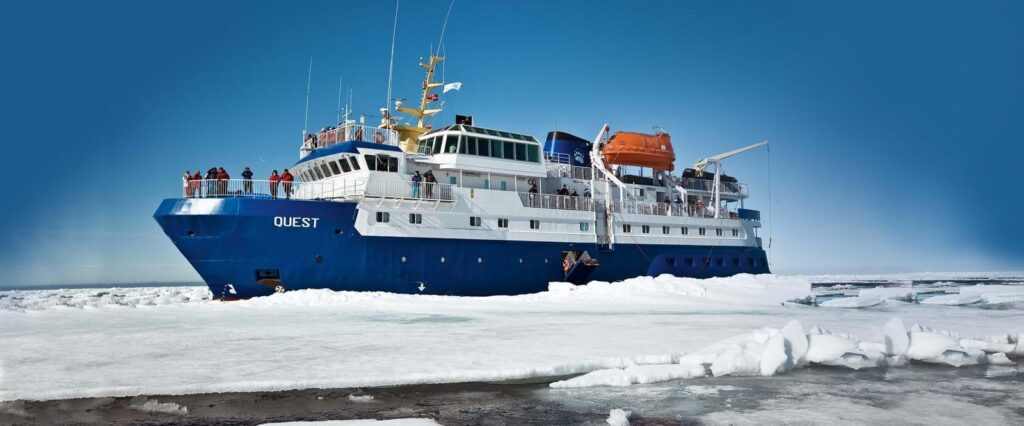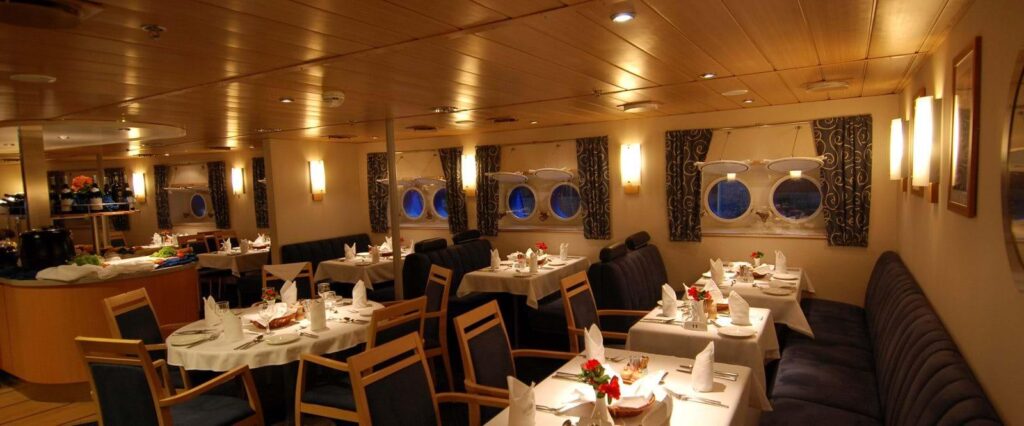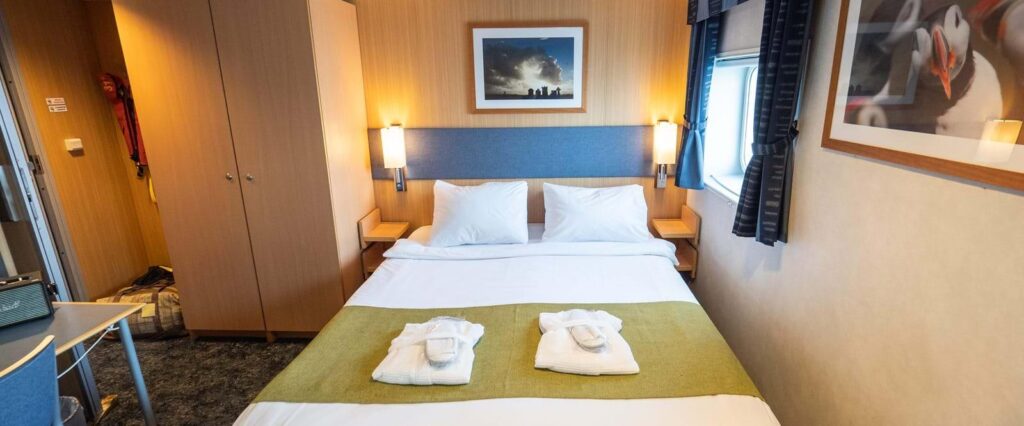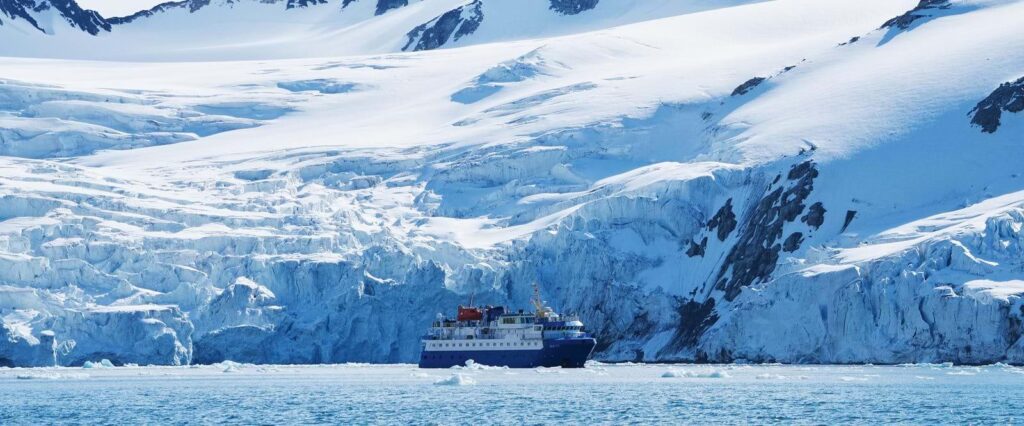Blog
The Ibex Expeditions Arctic expedition May 2023

OVERVIEW OF THE CRUISE
Experience an unforgettable Svalbard adventure with the small and comfortable expedition ship. In June, the midnight sun reigns supreme, the bird colonies are teeming with life and the peaks of the dramatic mountain ranges are beautifully snow-covered. The ice still keeps the islands in its grip and we can admire the ever-changing ice formations. Spring has arrived and summer is just around the corner.
We stay one night at a hotel in Longyearbyen and then spend seven nights on board our expedition ship exploring the unique Arctic wilderness of Svalbard. We cruise along glistening glaciers, go ashore to enjoy the magnificent nature and keep a lookout for unique
wildlife such as walruses, seals and polar bears.
Highlights:
- A true Arctic adventure
- 1 night in Longyearbyen
- 7 nights on the small expedition ship
- Magical midnight sun
- 5 * wildlife and nature experiences
- 5 experienced guides
- The trip is 100% climate compensated.
Mandip Singh Soin FRGS – Leader
Over the last 45 years, Mandip Singh Soin has climbed, trekked, skied, skydived and indulged in diverse adventures across 7 continents.Ibex Expeditions, India, was born in 1979, a pioneering and bespoke adventure, safari and luxury travel company, recipient of national and international awards. Ibex promotes journeys in India and exotic destinations around the globe.
Life’s adventures drew Mandip closer to saving the environment for future generations and his attention turned to making a difference and became the Founder President of the Responsible Tourism Society of India. Mandip is the recipient of several awards and is often called a ‘modest badass’!
Mandip finished a Masters in History at St Stephens College, Delhi University, loves puns and Beethoven and can flip an omlette to perfection.
Anita – Co-Leader
Anita is an artist, poet and a writer and a Director and co-owner at Ibex Expeditions for 30 years. She has hiked and biked, trekked and rafted and travelled to all seven continents and continues to explore her creativity, designing journeys that become works of art themselves. She studied at University and is an alumnus of the Welham Girls School.
Be inspired by our digital polar lectures!
Few trips can compare with a magnificent adventure to the realm of the polar bear, Svalbard, or the world’s most remote continent, Antarctica. Our Expedition leader, Adam Rheborg has recorded short lectures on what it’s like to travel to these spectacular places on earth.
Adam has been guiding adventurous tourists amongst polar bears and walruses in Svalbard since over 20 years. He works full time as expedition leader, dive master, television reporter, journalist and lecturer with the whole planet as his workplace.
ABOUT THE SHIP
The ship was built in Denmark in 1992 to serve as a ferry on Greenland’s west coast. In 2004/2005 she was completely refurbished into a comfortable expedition ship and in 2018 she underwent a renovation of the passenger areas. The ship takes 53 passengers and all 26 cabins are outside cabins with private facilities.
The triple cabins have upper and lower berths. All other cabins have two lower berths or a double bed. In your cabin you find a desk with a chair and a cupboard for storage. The superior cabins are spacious and have armchairs and TV. The owner’s cabin has a double bed, two large picture windows, a separate seating area and TV.
In the dining room you are treated to delicious meals in between landings and in the panorama lounge you can enjoy breath-taking views of the surrounding landscape. Here you can listen to entertaining talks on the area’s flora, fauna and history. In the lounge you also find a bar and a small library.
The ship has spacious observation decks, where you can enjoy the beautiful vistas. Passengers are welcome on the bridge around the clock and there is always something to see or search for. You are welcomed by an international crew and the atmosphere is relaxed and very friendly. There are five Zodiacs and five guides on board.







ITINERARY
Day 1 Longyearbyen, Svalbard
We arrive in Longyearbyen and transfer to our hotel.
Day 2-8 Expedition cruising
We start our great adventure in Svalbard by exploring Longyearbyen. In the afternoon we embark the expedition ship and sail out through Isfjorden – the Arctic expedition has started! We are now in a part of the world where we are totally dependent on the ice and weather conditions. Our exact itinerary depends on these factors and on the wildlife we encounter. Our ambition is to make landings or cruises every day with our Zodiacs.
Here are some examples of places we may visit.
Prins Karls Forland
This narrow strip of land is covered by a magnificent and snow-covered mountain chain. The island is also home to many seabirds and harbour seals.
Virgohamna, Danskøya
Two of the most courageous attempts to reach the North Pole started on the island of Danskøya. Swedish explorer Andrée made an attempt with a hydrogen balloon and American journalist Wellman started with an airship. There are still interesting remnants from these expeditions left on this site.
Fantastic fjords
Svalbard offers the visitor countless spectacular fjords. During our journey we will explore a few of them such as: Liefdefjorden, meaning “The fjord of love”, is lined with snow-covered mountain peaks and here we hope to cruise along the face of the spectacular Monaco Glacier.
Many common eiders and pink footed geese nest in the area and if lucky we could see the rare king eider. In Krossfjorden we revel in the beautifully sculptured front of the 14th of July Glacier to the raucous greeting of the large number of kittiwakes and Brünnich’s guillemots nesting on the nearby cliffs. Raudfjorden is an area of immense natural beauty – dominated by beautiful glaciers. It is also a favorite spot for seals and the bird cliffs are bursting with activity.
The scientific village of Ny-Ålesund is situated in Kongsfjorden. It was from here that Amundsen and Nobile started their heroic expeditions to the North Pole.
North Spitsbergen
North of Spitsbergen we might meet the edge of the pack ice. Not many ships venture here and we can marvel at the silence and grandeur of this icy landscape. Chances of meeting polar bears increase as we sail along the ice floes.
Southwest Spitsbergen
The grand fjords of Hornsund offer spectacular glaciers and a breathtaking landscape of towering mountain peaks, often reaching above the clouds. On a clear day we can see the summit of the highest mountain Hornsundtind, measuring 1431 meters. Hornsund is a favorite haunt for some of Svalbard’s polar bears and bearded seals are often seen resting on the fjord ice.
Day 9 Longyearbyen
Early morning we disembark our expedition ship and begin our journey back home.
Please note: Our exact route will depend on ice, weather conditions and wildlife. The places mentioned are just examples of some of the many sites Svalbard has to offer. We always strive to maximize your experience. Please remember that flexibility is the key to a successful expedition.
Flights
Climate compensated group flights from Oslo to Longyearbyen and return is available. (Limited availability).
SAFETY
The ship exceeds all SOLAS-requirements (Safety of Life at Sea) and is equipped with the latest communication- and navigation equipment
LIFEBOATS & LIFE RAFTS
LIFE-SAVING EQUIPMENT FIRE SAFETY
The ship has a total lifeboat and raft capacity of 160 passengers. It consists of two lifeboats with space for 45 passengers in each and 2 life rafts with space for 35 passengers in each.
The boats and rafts are equipped with drinking water, survival equipment and survival food rations and sea-sickness pills.The diesel-powered boats are also equipped with navigational equipment, medication, and communication equipment.
For emergencies, the ship has an overcapacity of life vests and the highest grade of Immersion Suits.The ship is equipped with automatic smoke detectors, a sprinkler system and fire safety doors. Fire alarms and fire extinguishers are placed around the ship.
COMMUNICATION ENVIRONMENTAL PROCEDURES OBSERVATION DECKS
For passenger use, the ship can offer an onboard e-mail account charged by a setup fee and a data transmission rate. This e-mail account can be accessed from the passenger’s laptop via a wireless network from almost anywhere on the ship.The passengers can also buy phone cards for the satellite phone available in the lobby on deck 4.
The tap water is drinkable and of high quality. All freshwater is produced on board from seawater. The system is oversized, and the purified and desalinated water is stored in buffer tanks in case the purification system should fail. All sewage is taken care of onboard the ship.
The three-stage cleaning system is based on the latest technology and before the sewage is released into the sea it’s completely decontaminated. The remaining waste products are emptied and taken care of by special vehicles or ships when the ship is in port.
All rubbish created onboard is sorted and whatever is recyclable is handed over for recycling while in port after each expedition. For the laundry, they use organic detergent, and, in the shower, there are organic protera body wash, shampoo/conditioner and body lotion
Curiosities about Longyearbyen
- There are no street names in Longyearbyen, they only use street numbers.
- Longyearbyen was named after the American John Munroe Longyear, who founded the Arctic Coal Company in 1906. The settlement was first named Longyear City but was later changed to Longyearbyen.
- If visiting Ny-Ålesund, you can send a card from the northernmost post office in the world. But please note that it can take weeks before the card arrives at its recipient.
- Common practice is to leave your shoes at the entrance, this to keep the coal dust out.
- Longyearbyen houses are built on stilts, due to the permafrost.
- During four months of the year, from around 25th October, the polar night occurs, and the sun never rises.
- During four months of the year, from around 19th April, the midnight sun reigns supreme and the sun never sets.
Equipment
The mean temperature in Longyearbyen in June +2ºC. In other parts of the archipelago the temperatures are a few degrees below the mean temperature in Longyearbyen. Due to the wind factor the temperatures sometimes seem to be much lower.
We recommend you dress in layers, it allows you to easily adjust to variations in temperature. Wear three layers or more. To get rid of perspiration, insulate you from the cold and protect you against the wind. The layering method also allows you to easily adjust your clothing when the weather and temperatures change. Make sure to bring an extra layer if you are travelling early or late season, as the temperature can be a bit lower.
When going ashore by Zodiacs, make sure to wear waterproof jacket/trousers and tall rubber boots. Below you will find some instructions on how to dress in polar climate, followed by an equipment checklist.
THE INNER LAYER
The layer closest to your skin must get rid of perspiration from your body to keep you dry and warm. Recommended materials are wool or synthetic materials. Cotton should never be worn close to the body.
THE MIDDLE LAYER
This layer provides insulation and retains body heat without restricting movement. Suitable materials for this layer are fleece or wool. It is better to wear several thin layers than one thick layer. On cold days you may need extra insulation. This way you control your body temperature.
THE OUTER LAYER
The main function of this layer is to offer protection against the wind and water, but also to let out excess body heat. Therefore, it is good to use breathable materials such as Gore-Tex or similar.
THE TOP
Your head is like the body’s funnel and we always recommend bringing a warm hat! Preferable materials are synthetic fibre or wool, if possible windproof.
HANDS AND FEET
These parts of your body are particularly sensitive. It is important to keep hands and feet dry and warm. The same layering method applies here. Use inner gloves made of synthetic fibre, silk or wool and cover with a wind/waterproof mitten. Mittens are much warmer than gloves. Please remember to bring an extra pair of mittens. You should wear inner socks of synthetic fibre and cover with layers of wool or synthetic socks. A pair of solid knee-high rubber boots is the secret weapon when going ashore with the Zodiacs. It is also wise to bring wool insoles.
CONSERVATION & SAFETY GUIDELINES
LANDINGS WITH ZODIACS
Always pay attention to your expedition leader and guides. Do not hesitate to ask them if you have questions regarding the landing procedures. Passengers must be aware of certain regulations involving the Zodiacs in order to ensure safety in our operations. A briefing will also be given by our guides.
The boat driver oversees the boat and its operations. His/her instructions must always be followed.
There will be wet landings (you will need to wade ashore). We advise passengers to wear rubber boots and appropriate waterproof clothing as protection from sea spray or rain when in the rubber boats. Use a water proof bag (or bring along a small plastic bag) to protect items such as cameras and binoculars.
Always wear the life jackets provided when in the rubber boat. This is for your safety, and is required at all times regardless of weather and sea conditions.
Accept the helping hands of crew members and drivers when stepping into or out of the rubber boat at the ship’s gangway. Keep both hands free for this operation, and use the “Sailor’s grip” (i.e. grip each other by the wrist).
Minimize the number of items you bring into the rubber boat. Backpacks are ideal for loose items such as cameras, binoculars, medication etc. It allows you to have both hands free.
If you have a loose item, it should be handed to the driver/crew member before embarking/disembarking the rubber boat.
WILDLIFE & NATURE
When ashore, always stay with your group and your guides. Due to polar bears and for your safety, never wander off on your own.
Watch your step and keep to established paths when possible. In cold and dry habitats the recovery of plants is very slow.
Be extremely careful among breeding colonies of seabirds and ground nesting birds.
Approach wildlife slowly when taking photographs and retreat from the subject just as carefully.
Never disturb wildlife for the sake of a photograph.
Be careful not to startle or chase any bird from its nest. Your attention to a nesting or molting bird should never be prolonged when a predator is in the vicinity. Foxes, gulls and skuas are always luring to raid exposed nests.
Monitor your surroundings and be sensitive to any disruption you may be causing. If an animal shows signs of distress or avoidance, move away.
Look but never touch. These are wild animals going about their daily business. We wish to observe natural behavior in its natural state.
Never feed wild animals.
In order not to introduce new species into Svalbard please wash your boots at home and make sure that no seeds are included in the packaging or clothing (pockets, Velcro, etc.).
Return all litter to the ship for proper disposal. This includes litter of all types, such as plastic bags and paper tissues.
It is not allowed to collect natural souvenirs such as shells, rocks, feathers, bones or fossils.
Keep noise level to a minimum.
Never smoke ashore.
BINOCULARS & PHOTOGRAPHY
Good binoculars are highly recommended and will add quality to your travel experience.
All binoculars are listed by power and brightness, e.g. 8×32 or 10×50. The first number indicates magnification and the second the diameter of the front lens. At least 8 x-powers is recommended, 8×32 or 10×42 binoculars are good choices.
“Wide-field” binoculars allow you to see a wider area making it easier to spot wildlife.
Compact models, in the 8×25 range, can fit in a pocket and are very lightweight, but sacrifice brightness and field of vision.
Rubber coated models are generally more shock resistant and some of these are also waterproof.
PHOTOGRAPHY
For many of us, photography is a natural part of travel. Therefore, we have summarized the most basic recommendations regarding photography.
Equipment
Whatever type of camera you use, make sure it is working properly before you leave home. If you have a new camera or have a camera that has not been used for a while, it is a good idea to take some pictures before travelling to ensure that it works properly. Also remember to bring your camera manual.
Batteries
Bad batteries account for the largest percentage of camera problems on expeditions, especially in cold climates. For this reason, please bring extra camera batteries with you, even if the one in your camera is new.
Memory cards
Rule of thumb is to bring more memory cards than you believe you will need.
Tripods and Beanbags
Tripods, which are often used to steady cameras with large telephoto lenses, are not useful on ships, as they tend to transmit the ship’s vibrations. If you are bringing a lens larger than 300 mm, you might consider bringing a beanbag to support your camera. Unlike tripods, beanbags tend to absorb the ship’s vibrations.
Maintenance
Particles or water can easily stick on the camera lens, which can reduce the image quality. For this reason, we recommend you to bring a microfiber cloth designed for optics.
Storage
Cameras are in general sensitive to water, moisture and shock. A bag/backpack for protection is recommended.